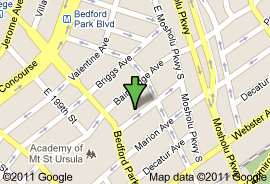Nine Queen Anne style homes on Perry Avenue in the Bronx designated as a historic district. On December 15, 2009, Landmarks designated a row of Queen Anne style houses at 2971 to 2987 Perry Avenue in the Bronx as the Perry Avenue Historic District. The historic district, which is the City’s 100th, consists of nine three-story, wood-frame houses built between 1910 and 1912. Following the extension of the IRT and the Third Avenue elevated line … <Read More>
Search Results for: Fieldston, Bronx
Bronx historic district approved
Council finds no support for discrimination allegation. The full Council approved Landmark’s designation of the Fieldston Historic District in the Bronx on April 26, 2006 after members of the Land Use Committee rejected allegations of discrimination surrounding the designation. 3 CityLand 12 (Feb. 15, 2006).
At the April 11th vote of the Land Use Committee, Council Member Simcha Felder stated that during the designation process some opponents claimed that the designation was “being used to … <Read More>
Fieldston Designation gets Council hearing
Many in community testified in opposition to landmarking of Bronx neighborhood. On March 28, 2006, the City Council’s Landmarks, Public Siting & Maritime Uses Subcommittee held a hearing on the designation of the Fieldston Historic District, located in the northwestern portion of the Bronx. The 97-year-old community’s historic significance lies in its winding roads and eclectic mix of Medieval, English, Tudor, Dutch, and Mediterranean architecture. Fieldston was unanimously designated by Landmarks in January, 2006, despite … <Read More>
Landmarks designates Fieldston Historic District
Planned 1909 Bronx suburb designated. At a January 10, 2006 Landmarks meeting, the Commission unanimously voted to designate the Fieldston community in the Bronx as a historic district. Fieldston is an example of an early twentieth-century planned community that evolved to incorporate modern design as well as Medieval, English, Tudor, Dutch, and Mediterranean architecture. Landmarks Chair Robert Tierney hailed the designation as part of the Commission’s “goal to designate landmarks and historic districts throughout the … <Read More>
Landmarks Leaves Only One Backlog Item Remaining After Last Meeting of 2016
Ten of thirteen items brought to a final disposition were designated by Landmarks and will proceed to City Council for ratification. On December 13, 2016, the Landmarks Preservation Commission made its final dispositive votes on items prioritized for designation in the commission’s Backlog Initiative, with one exception. The initiative, began in 2015, sought to address the backlog of designation items that had been added to the commission’s calendar before 2001 but never brought to … <Read More>
NYC Landmarks Law and Regulation of Open Space
The Landmarks Preservation Commission (LPC) has jurisdiction over both buildings and landscape features on landmarks sites. But the Commission rarely directly regulates changes to landscape features. For routine landscaping changes and in urban contexts, the landscape features are rarely a concern. In other cases the landscape takes on central importance. This is especially true where there where the existing landscaping and natural land features figure prominently in the beauty and importance of the site. In … <Read More>




